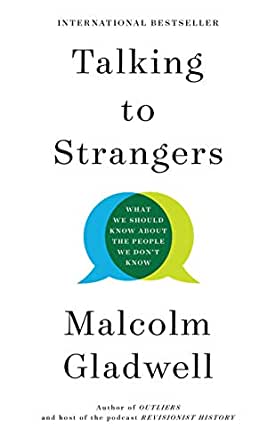Talking to Strangers by Malcolm Gladwell

Getting an accurate measure of a stranger is an important skill. Despite its importance, determining whether a stranger is trustworthy or not is a skill in which people are surprisingly poor. Anecdotally and in experimental conditions, people can only identify deceivers and non-deceivers when they are obvious, while making lots of false positives and false negatives in more ambiguous cases. Why does this happen? Shouldn’t natural selection have made us more astute and more capable of picking out untrustworthy people? As it turns out, people have various systemic mental habits that get in the way.
The first cognitive bias people make is defaulting to truth and assuming that everything they are told is true until proven otherwise. People give strangers the benefit of the doubt at first, changing their minds only when the evidence against the stranger becomes overwhelming. People who are victims of deceit can usually spot plenty of red flags and warning signs with the benefit of hindsight. However, none of the red flags were ever deemed significant enough to change the overall assessment of the person at the time.
Does this mean we can avoid getting conned by not defaulting to truth and instead assuming treacherous intentions from everyone we encounter? Trust is the foundation of civilization; anyone who refuses to participate in society because of paranoia will miss out on society’s benefits. Being a victim of deception or misplaced trust from time to time is part of the cost of doing business. The cost of never doing business is much higher.
The second cognitive bias people make is assuming that strangers are transparent. We assume that people’s outward expressions are a mirror into their internal feelings. We also tend to believe the same about ourselves, that our outward expressions betray our internal feelings and that we are easily readable. Both statements are only somewhat true. Many facial expressions and mannerisms are learned behaviors that can be tamed and controlled. The assumption of transparency causes us to get duped by con artists who tell their lies with boldness and confidence. At the same time, transparency makes us oversuspicious of truthful people who are acting nervously under questioning. Expressive data can be helpful, but it can also just be irrelevant noise that drowns out the signal. If you have supplemental information about a stranger besides their current in-person statements and expressions (eg their background and history), you may be better off by putting most of your attention on the supplemental information instead.
The third cognitive bias is neglecting the effects of contexts and coupling. Behavior is a function of a person and a situation. We tend to look too deeply into the person component of the equation and downplay the situational component, both for ourselves and for other people. We assume that people’s intentions are fixed, that good people are always good while treacherous people are always treacherous, and that there is little prospect of swaying other people’s behavior. People are much more malleable than they appear, especially when they are put outside of familiar and habitual situations.
